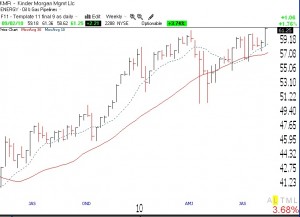Thursday was the 15th day of the current QQQQ short term down-trend. It will take a few more days of a rise to turn the QQQQ trend into an up-trend. Meanwhile, my short term indicators in the GMI-R have turned up, to +7. The GMI remains at +3. I generally like the GMI to be 4 or more to feel comfortable going long. A lot of stocks have bounced and it remains to be seen whether the market is setting up for a major up-trend.
With a possible up-trend on the horizon, it is time to look for stocks breaking out of bases. Stocks that break to new highs early in a market up-trend often become leaders in a real rally. KMR hit an all-time high on Thursday. Imagine a stock emerging from this weak market at an all-time high! KMR is also up 30% from a year ago. It looks like a cup-with-handle break-out, as this weekly chart shows (click on chart to enlarge). The volume on Wednesday was above its 50 day average, a good sign for a break-out. William O’Neil made the cup-with-handle chart formation famous. Note that KMR has also found support at its critical 30 week average (red line), and is in a StanWeinstein Stage 2 up-trend. If one purchases a stock breaking from a valid base, O’Neil’s research shows one should place a stop about 8% below the break-out price of 60.50. Valid break-outs, he says, rarely decline to 8% below the break-out point. That would mean a GTC (good-til-canceled) stop order to sell should be placed at about $55.50. My preference would be to place a stop order at 58.59, just below the 5 day low and the 10 week average (dotted blue line). KMR’s last quarterly earnings were up about 192%. Time will tell if KMR is a winner.
Among the stocks on my IBD100 and New America lists that hit an all-time high on Thursday are: CVLT, SXCI, APKT, CMG, TDG, EW, RHT, CRM, FOSL, INFA, OPEN, MFB, DLTR, BAP, CTXS, CLW, AAP, PCLN, MWIV, AZO, IT, LZ, MCD, CIB, NEOG, and SAN. Some of these will prove to be true winners and I own a few.
